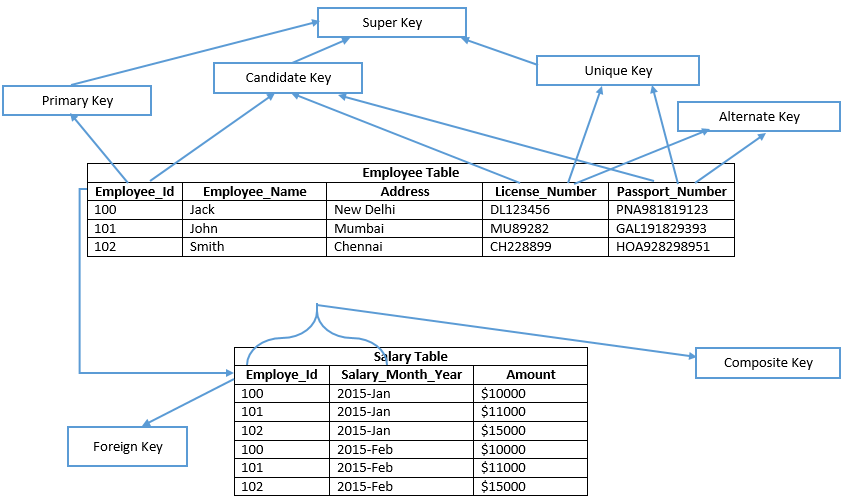Types of keys in DBMS
What is Key?
Keys are fields in a table which participate in below activities in RDBMS systems:
- To create relationships between two tables.
- To maintain uniqueness in a table.
- To keep consistent and valid data in database.
- Might help in fast data retrieval by facilitating indexes on column(s).
SQL Server supports various types of keys, which are listed below:
- Candidate Key
- Primary Key
- Unique Key
- Alternate Key
- Composite Key
- Super Key
- Foreign Key
Before discussing each type in brief, have a look on the below image used as an an example to define types of keys.
Lets discuss each type in detail:
Candidate Key
Candidate key is a key of a table which can be selected as a primary key of the table. A table can have multiple candidate keys, out of which one can be selected as a primary key.
Example: Employee_Id, License_Number and Passport_Number are candidate keys
Primary Key
Primary key is a candidate key of the table selected to identify each record uniquely in table. Primary key does not allow null value in the column and keeps unique values throughout the column. In above example, Employee_Id is a primary key of Employee table. In SQL Server, by default primary key creates a clustered index on a heap tables (a table which does not have a clustered index is known as a heap table). We can also define a nonclustered primary key on a table by defining the type of index explicitly.
A table can have only one primary key and primary key can be defined in SQL Server using below SQL statements:
- CRETE TABLE statement (at the time of table creation) – In this case, system defines the name of primary key
- ALTER TABLE statement (using a primary key constraint) – User defines the name of the primary key
Example: Employee_Id is a primary key of Employee table.
Unique Key
Unique key is similar to primary key and does not allow duplicate values in the column. It has below differences in comparison of primary key:
- It allows one null value in the column.
- By default, it creates a nonclustered index on heap tables.
Alternate Key
Alternate key is a candidate key, currently not selected as primary key of the table.
Example: License_Number and Passport_Number are alternate keys.
Composite Key
Composite key (also known as compound key or concatenated key) is a group of two or more columns that identifies each row of a table uniquely. Individual column of composite key might not able to uniquely identify the record. It can be a primary key or candidate key also.
Example: In salary table, Employee_Id and Salary_Month_Year are combined together to identify each row uniquely in Salary table. Independently Employee_Id or Salary_Month_Year column cannot identify each row uniquely. We can create a composite primary key on Salary table using Employee_Id and Salary_Month_Year columns.
Super Key
Super key is a set of columns on which all columns of the table are functionally dependent. It is a set of columns that uniquely identifies each row in a table. Super key may hold some additional columns which are not strictly required to uniquely identify each row. Primary key and candidate keys are minimal super keys or you can say subset of super keys.
In above example, In Employee table, column Employee_Id is sufficient to uniquely identify any row of the table, so that any set of column from Employee table which contains Employee_Id is a super key for Employee Table.
For example: {Employee_Id}, {Employee_Id, Employee_Name}, {Employee_Id, Employee_Name, Address} etc.
License_Number and Passport_Number columns can also identify any row of the table uniquely. Any set of column which contains License_Number or Passport_Number or Employee_Id is a super key of the table.
For example: {License_Number, Employee_Name, Address}, {License_Number, Employee_Name, Passport_Number}, {Passport_Number, Employee_Name, Address, License_Number}, {Passport_Number, Employee_Name}, {Passport_Number, Employee_Id} etc.
Foreign Key
In a relationship between two tables, a primary key of one table is referred as a foreign key in another table. Foreign key can have duplicate values in it and can also keep null values if column is defined to accept nulls.
Example: Employee_Id (primary key of Employee table ) is a foreign key in Salary table.
Note: Keys like primary key and unique key creates indexes with keys columns. Indexes organize their data in B-Tree structure (Balanced Tree: Leaf nodes are all at the same level from the root node) in SQL Server. Nonclustered index creates a separate structure from the base data table but clustered index converts base data table from heap structure to a B-Tree structure. Clustered index does not create a separate structure apart from base table and that is the reason we can create only one clustered index on a table. We can sort a table in only one way (it may have multiple columns to sort but sorting can be done in one only way) which is the order of clustered index.

Comments
Post a Comment